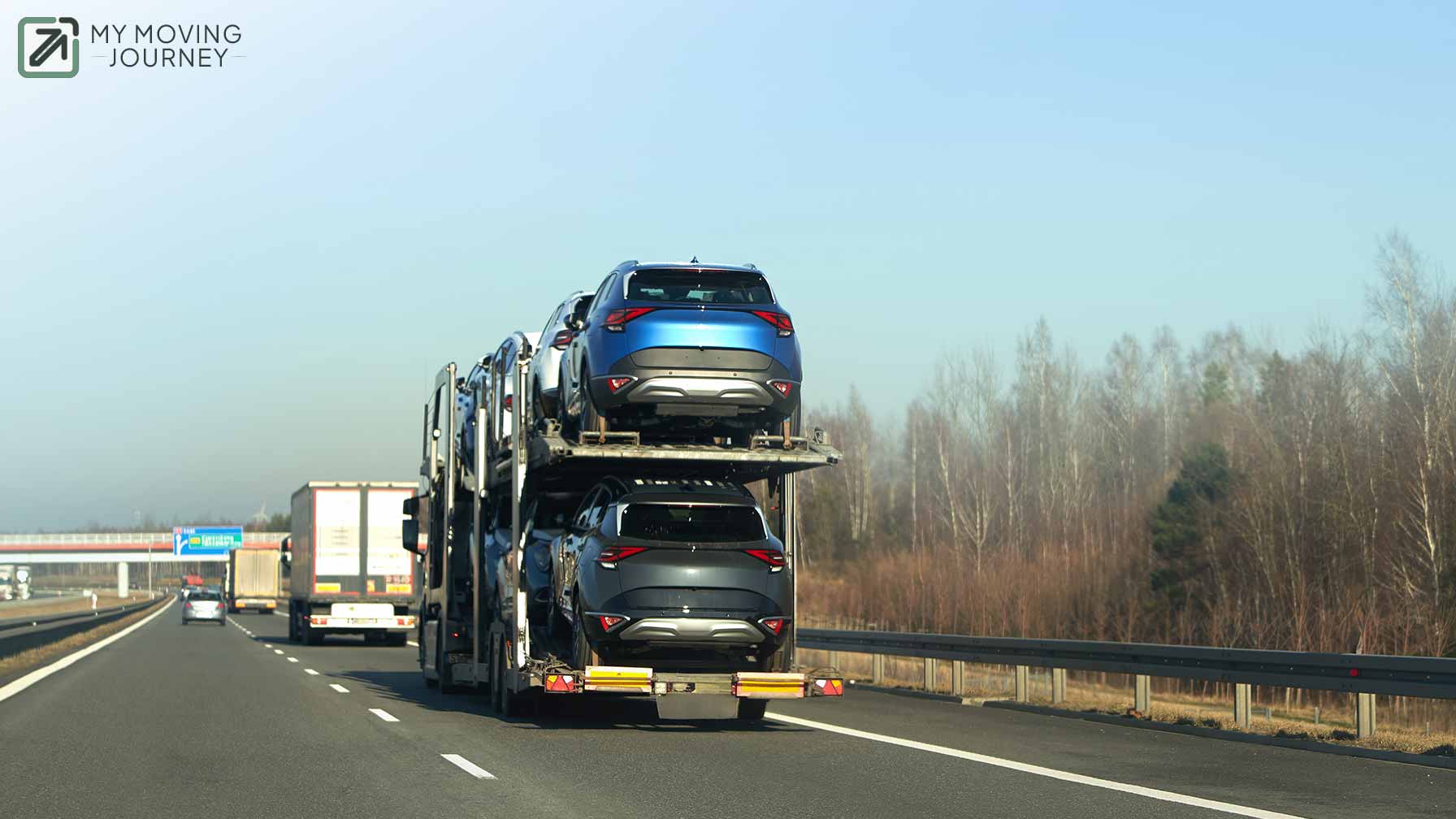The journey of a thousand miles begins with a single step.
Moving to a new state can feel exactly like this: a combination of excitement and stress, especially when it comes to figuring out what to do with your car.
Getting your vehicle to your new state safely and affordably can be one of the trickiest parts of the journey.
Did you know that, according to the U.S. Census Bureau, over 27 million Americans relocate annually, and nearly 3 million vehicles are shipped across states annually?
This demand has driven the U.S. car shipping industry to a value of over $12 billion in the previous year.
When it comes to moving, many people assume they will drive their car to the new location. But long-distance moves, especially cross-country ones, can be exhausting, time-consuming, and risky for their vehicles.
In fact, experts estimate that driving a car across the coast in the U.S. adds about 2,800 to 3,000 miles of wear and tear.
Then there is the cost aspect. Long-haul driving, however, can be nearly as expensive as transportation.
This is where car shipping services can be handy.
It provides choices based on your requirements, budget, and time.
In response to the marked increase in relocations, the industry has adjusted accordingly, offering flexible solutions ranging from air transport to enclosed trailers that safeguard high-end assets.
The industry has responded to the rise in relocations by providing flexible services, from air transport to enclosed trailers that protect luxury vehicles.
On average, shipping a car within the U.S. costs between $700 to $1,500.
A cost that many people find reasonable due to the convenience and peace of mind it offers.
Let’s discuss everything you need to know about how to ship a car to another state.
Basics of Car Shipping Services
Imagine you are planning a move across the country, and driving your car all that way isn't feasible.
That’s why you need car shipping services.
They are designed to transport your vehicle safely and efficiently to your new location.
Methods of Car Shipping
There are several methods to consider:
Open-Air Transport: This is the most common and cost-effective method.
Your car is loaded onto an open trailer, similar to the ones you see transporting multiple vehicles on the highway.
However, since it's exposed to the elements, there's a slight risk of climate wear or road debris.
Enclosed Transport: If you own a luxury, classic, or high-value vehicle, this option offers added protection.
Your car is placed inside a covered trailer, which shields it from weather and road hazards.
This service typically costs about 30-40% more than open-air transport.
Door-to-Door Service: The carrier picks up and delivers your vehicle directly to your specified addresses.
This is the most convenient option but comes at a higher price.
Terminal-to-Terminal Service: You drop off and pick up your vehicle at designated terminals.
This can be more economical, but it requires additional coordination on your part.
Steps To Ship Car To Another State
Select a Reputable Carrier: Always go for companies with positive reviews, proper licensing, and insurance.
The Federal Motor Carrier Safety Administration (FMCSA) is a great place to check credentials.
Request Quotes: Get several quotes to see what each charges and offers. Always make sure all fees are transparent.
Prepare Your Vehicle: Clean out your car, remove personal items, and take pictures of its condition.
Schedule Pickup and Delivery: Arrange pickup and delivery dates that correspond to your move and ensure someone will be present at both locations.
Review the Bill of Lading: This document shows both the terms of transport and the state of the vehicle. It should be examined carefully each time before you sign it.
Insurance Considerations
Most car shipping services provide insurance, but it is compulsory to:
Verify Coverage: Understand what damages are covered and any exclusions.
Check Your Personal Auto Insurance: Some policies may cover vehicle transport; confirm with your provider.
Additional Coverage: It is wise to purchase extra insurance for high-value vehicles.
How to Prepare Your Car for Transport
Preparing your car for transport might feel like an extra step, but trust us, it’s well worth the effort to make sure your vehicle arrives in the same condition it left in.
Clean Your Car Inside and Out
A clean car makes it easier to spot any pre-existing scratches, dents, or dings.
Plus, shipping companies require a pre-transport inspection, and dirt can mask potential issues.
According to car transport experts, about 70% of vehicle damage during transport is minor, so knowing your car’s condition beforehand helps you catch any post-transport dings or scuffs.
Document the Condition with Photos
Take clear, dated photos of your car from all angles and close-ups of any existing damage.
In case of any issues upon delivery, these photos will be invaluable as proof of the car's condition before transport.
According to industry standards, over 90% of car shipping claims are resolved more quickly when there is pre-existing photographic evidence.
Remove Personal Items and Accessories
It’s tempting to pack a few belongings in the car, but most transport companies don’t allow it due to weight and liability issues.
Personal items increase the risk of damage, theft, and fines because some states have regulations against this.
Check for Leaks and Mechanical Issues
Make sure there are no fluid leaks and that your car is in good mechanical condition.
Carriers can refuse to transport vehicles with leaks, as they may damage other vehicles on the trailer.
Additionally, make sure your battery is fully charged, and the tyres are properly inflated to prevent any complications during loading and unloading.
In fact, 2 to 3% of car transport delays are due to last-minute mechanical issues.
Limit Your Fuel Level
Carriers recommend leaving the gas tank about a quarter full, enough for basic handling but not so much that it adds extra weight.
According to shipping industry estimates, keeping the fuel level low can reduce the shipping weight by 10-20 pounds.
How Much Does it Cost to Ship a Car to Another State?
Let’s talk numbers because I know one of the first things you are wondering is, “How much is this really going to cost?”
Shipping a car to another state involves many variables, each of which affects the final price.
Main Cost Factors in Car Shipping
Shipping costs depend on a few key factors.
Distance and Route
Simply put, the longer the distance and route, the higher the cost.
For example, shipping within 300 miles could cost around $400-$600, while shipping coast-to-coast could range from $1,200 to $1,500.
Type of Transport
Open-Air Transport: It is suitable for most vehicles, especially everyday cars. You can expect this to cost 30-40% less than enclosed transport.
Enclosed Transport: If you are shipping a luxury, exotic, or classic car, enclosed transport is ideal as it offers protection from weather and road debris. However, it comes with a premium price tag.
Vehicle Size and Weight
Larger and heavier vehicles, like SUVs and trucks, cost more to transport compared to sedans and compact cars.
Heavier vehicles require more fuel, which increases the cost.
Season and Timing
High-demand seasons like summer and the holidays typically increase rates. The winter months (except for holiday travel) tend to have lower rates.
Delivery Options
Door-to-Door Service: The convenience of picking up your car at your home and delivering it directly to your new address comes with a higher price.
Terminal-to-Terminal Service: Dropping off and picking up your car from a designated terminal saves company resources and is cheaper.
Average Shipping Costs
Here’s a table showing typical costs based on distance and whether you choose open or enclosed transport.
Remember, these are rough estimates to give you a starting point:
| Distance (Miles) | Open-Air Transport (Standard Vehicle) | Enclosed Transport (Luxury/Classic Vehicles) |
|---|---|---|
| 0 - 500 | $500 - $700 | $700 - $1,000 |
| 500 - 1,000 | $700 - $1,200 | $1,000 - $1,500 |
| 1,000 - 1,500 | $1,000 - $1,500 | $1,500 - $2,000 |
| 1,500+ | $1,200 - $1,700 | $1,700 - $2,500 |
Additional Costs to Consider
Beyond basic transport fees, here are some other potential charges to keep in mind:
| Additional Service | Estimated Cost |
|---|---|
| Insurance (for extra coverage) | $50 - $300 |
| Expedited Shipping | $200 - $500 |
| Fuel Surcharge | 5-10% of total transport cost |
| Oversized Vehicle Fee | $100 - $500 |
| Seasonal Surge (Peak Season) | 10-20% added to base transport cost |
Total Cost Estimation Example
To put it all together, here's an example of a cross-country move:
Suppose you're shipping a standard-sized sedan from Los Angeles to New York (about 2,800 miles) with open-air transport during peak season (summer), and you need additional insurance for a high-value car.
Here’s how the costs might add up:
| Service | Estimated Cost |
|---|---|
| Base Shipping Cost | $1,200 - $1,500 |
| Seasonal Surge (10%) | $120 - $150 |
| Additional Insurance | $100 |
| Total Estimated Cost | $1,420 - $1,750 |
In this case, you are looking at a rough total between $1,420 and $1,750.
Tips for Getting the Best Quote
Compare Quotes: Reach out to multiple car shipping companies and compare their rates. Look for transparent pricing that includes all fees.
Ask About Discounts: Some companies offer discounts for students, military members, and AAA members.
Check for Hidden Fees: Be sure to ask about any additional fees upfront, as some companies may not include everything in their initial quote.




